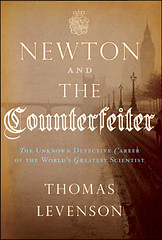
PREV ARTICLE
NEXT ARTICLE
FULL ISSUE
PREV FULL ISSUE
BOOK REVIEW: NEWTON AND THE COUNTERFEITER BY THOMAS LEVENSONBill Eckberg writes: I thought your readers might be interested in a hard science journal's review of what is essentially a numismatic story. Of course, Newton did have a career outside of coin production
Bill forwarded a copy of a review in a recent issue of Nature magazine of Thomas Levenson's Newton and the Counterfeiter: The
Unknown Detective Career of the World's
Greatest Scientist. We've mentioned the book before, but I haven't had a chance to pick it up yet. Here are excerpts from the Nature review.
-Editor
After the Glorious Revolution of 1688, in which King James II of England was overthrown by a union of Parliamentarians led by William of Orange, the English government found itself in dire financial straits. It had joined the War of the Grand Alliance against France in 1689, and was struggling to fund its army in a conflict that was to last for another 8 years. To make matters worse, the country was suffering from a lack of good coinage. As Thomas Levenson explains in his engaging book Newton and the Counterfeiter, the government turned to an unlikely hero to save the nation from financial calamity — Isaac Newton. An unlikely appointee for the role, he was at that time enjoying fame as the author of Principia Mathematica, his seminal work on the foundations of physics, and had just embarked on a radical change of career as a politician. Although the job had been treated as a sinecure by most of his predecessors, Newton took it on with vigour. He masterfully oversaw the great re-coinage and, after overcoming his initial revulsion, prosecuted with relish the clippers and ‘coiners', or counterfeiters, who were partly responsible for the disarray of the country's currency. It wasn't long before his role brought him up against the arch-counterfeiter and forger, William Chaloner, whose skill and success in faking French pistoles (gold coins) and English guineas had quickly taken him from poverty to riches. The book documents the entertaining relationship between these two geniuses and the different worlds they inhabited. Although their story is well known to historians of science, Levenson's account adds substantially to our knowledge of the social and political background against which it played out. The author manages to unpick many of the tangled and morally ambiguous webs that made up the metropolitan counterfeiting culture of that era, and shows — impressively, given the scant sources available — how Chaloner pulled off many of his brazen schemes.
It is an enthralling tale.
The Numismatic Bibliomania Society is a non-profit organization promoting numismatic literature. See our web site at coinbooks.org. To submit items for publication in The E-Sylum, write to the Editor at this address: whomren@gmail.com To subscribe go to: https://my.binhost.com/lists/listinfo/esylum All Rights Reserved. NBS Home Page Contact the NBS webmaster 
|
